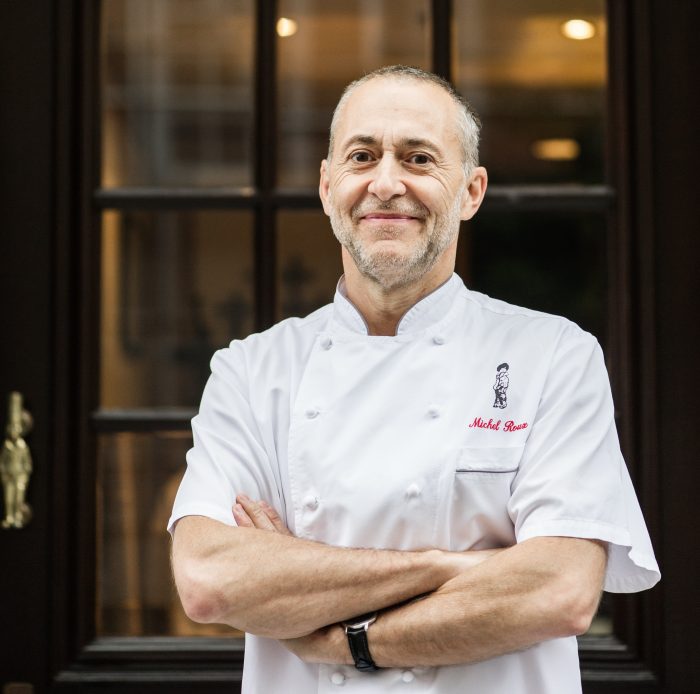The rule of the Roux
Author: Will Lyons

Michel Roux Jr outside Le Gavroche
On the far wall of the chef’s library, deep inside the Mayfair terrace which houses Le Gavroche, there is a small television screen relaying a live stream from the kitchen. It shows a hive of activity, as a variety of chefs bustle around the large range in preparation for lunch, when the chef’s library will be transformed into an intimate six-seater dining room. But, this morning, it’s the working office of Michel Roux Jr, two-star Michelin chef, serial marathon-runner, television personality as well as author of several cookery books, including the 2005 guide Matching Food & Wine: Classic and Not So Classic Combinations.
In the rarefied world of London’s fine dining scene, Michel Roux is a rare breed: a Michelin-starred chef with not only an interest in the history of French cuisine (on the wall hang some of the world’s oldest original restaurant menus, including examples from 19th century Parisian restaurants Veron et Baron and Lavenne), but also someone who knows his way around a wine list and implicitly understands the enjoyment of food and wine.
“I lament the fact that a lot of chefs don’t get it,” he says, fiddling with his glasses and keeping one eye on the live stream to the kitchen. “They don’t understand wine and I suppose it is because they are scared.”
At Le Gavroche they have been laying down wine to mature since the early 1970s. Their cellar contains around 15,000 bottles and is replenished every year with the latest en primeur releases.
“It is a massive investment,” he says. “I don’t think that restaurants now could do what we have done over the last 50 years, continuously buying up our allocations ever year and growing the wine list.” He shows me a list from when the restaurant first opened. It’s an enviable selection with eight different Bordeaux châteaux from 1945 including Chx Lafite, Latour and Pétrus, as well as 1947 Mouton Rothschild. But there is also a Pommard by Lupé Cholet from 1915 and vintages from Alsace, Beaujolais, the Loire and Rhône. In a French restaurant people expect to drink French wine, he insists.
“Wine plays a very, very important part in the pleasure of dining,” he says. “From a very young age I always looked at what wines go best with what I am eating at the time. And, when it works, it is magical. It is like a bolt of lightning striking.”
He points to classic pairings such as Sancerre and goats’ cheese, and the “tried and tested” Pauillac with lamb, but also suggests pairing Champagne with food.
“Champagne is an extremely versatile wine,” he says. “A lot of people think of it as an apéritif and something to drink as a celebration but it is actually a really complex wine which can work perfectly with food throughout a menu, especially if you go with vintage Champagne. Creamy sauces with certain cheeses, such as a Camembert or Brillat-Savarin, go well with good-quality Champagne.”
He explains that traditionally in France the local wine is served with the local food. “Think of a glass of great Cahors,” he says (the dark, savoury black wine made from Malbec in the south-west of France) with a slice of hefty confit du canard. “Those lovely tannins work well with the goose fat. It works so well and that is not luck, it is years of heritage.”
Heritage is something the Roux family do well. Ever since his father, Albert, opened Le Gavroche with his brother Michel Roux Sr in 1967, the family’s influence on Britain’s culinary culture has been startling. Le Gavroche was the first restaurant to be awarded a Michelin star outside France (it still holds two today) and its alumni – which include Pierre Koffman, Marco Pierre White and Gordon Ramsay – read like a Who’s Who in the contemporary revival of London’s restaurant scene.
Michel grew up in what he describes as a French household in England. “I have tasted wines from a very, very young age, as that is the French way,” he says. “Children learn about the flavours of wine and all the pleasures of dining at a table together. But, as a child growing up in a French household, Dad would always stick a glass of wine under my nose and say have a sniff of that, smell this.”
He says that he remembers a particular occasion when his father insisted that he had to taste the wine. Usually if this happened he would dilute the wine with water but not this time. He tasted it and it was sweet; the young Michel was immediately intrigued.
“The taste was unbelievable, unlike anything I had tasted before,” he says. “My immediate reaction was that it had a real viscosity. I later found out it was a Ch. d’Yquem!”
It’s nearly time to go. Michel has to get back to the kitchen, a service awaits – but I have one last question for him, what sort of wine do they use for cooking? “From Provence,” he replies. “Keith Floyd was right, it has to be drinkable,” he laughs, and with that he is gone. Hopefully when lunch is over there will be time for a glass of wine.
Find out more about food and wine matching at our wine events.


